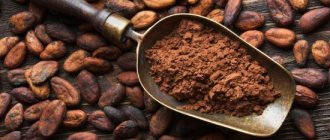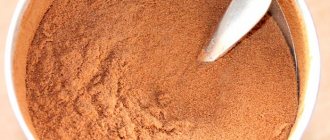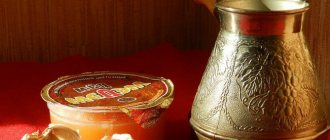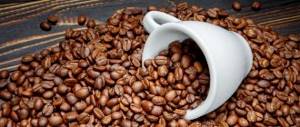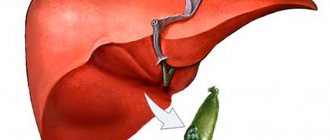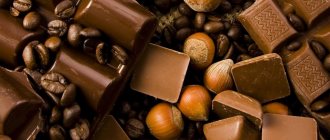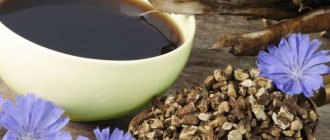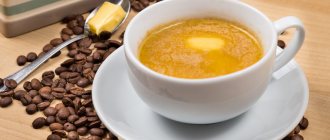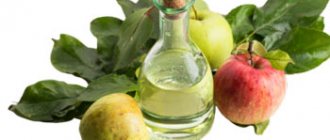Calorie content and chemical composition
There are more than 100 varieties of halva, but traditionally, the first place is occupied by sunflower, second by nut, third by tahini and sesame (purely oriental options). The chemical composition and calorie content of the species differ, which is explained by the variety of raw materials.
| Index | Sunflower | Nut (peanut) | Tahini | Sesame |
| Calorie content per 100 g | 516 | 490 | 507 | 470 |
| Proteins, g | 11,7 | 16,8 | 13,2 | 11,9 |
| Fats, g | 29,8 | 27,9 | 31,1 | 28,7 |
| Carbohydrates, g | 55 | 46,3 | 50,5 | 44,5 |
| Vitamins, mg | ||||
| Ascorbic acid | 3,2 | 4,3 | 5,5 | 4,7 |
| A nicotinic acid | 6,4 | 6,2 | 6,7 | 6,8 |
| Tocopherol | 17,8 | 19,9 | 22,9 | 21,2 |
| Thiamine | 0,9 | 0,8 | 0,8 | 0,8 |
| Riboflavin | 0,1 | 0,1 | 0,12 | 0,11 |
| Retinol | 0,1 | 0,1 | 0,13 | 0,11 |
| Minerals, mg | ||||
| Potassium | 352 | 432 | 275 | 312 |
| Magnesium | 189 | 168 | 304 | 239 |
| Calcium | 311 | 465 | 1500 | 1356 |
| Phosphorus | 298 | 367 | 401 | 345 |
| Sodium | 89 | 57 | 40 | 41 |
| Iron | 31,2 | 29,5 | 49,2 | 45,8 |
Temptations and bad habits
No matter how strong a person is, temptations await him everywhere:
- Everything is only becoming more accessible every year;
- The boundaries of morality and decency are being erased, even in conservative regions;
- Total control is impossible, so there is always a chance to “grab the forbidden fruit”;
- What was previously considered something unacceptable or immoral is now regarded as a completely normal phenomenon.
If someone tries not to waste their life - improves, develops, works, creates - even more opportunities open up before them. What you didn’t even have to think about a year ago is becoming very close and accessible.
But there is too much pathos and sublimity in all this; in fact, much more often problems arise with elementary moments:
- I want to drink, but I can’t - I have to drive;
- You want to smoke, but shortness of breath and lung problems are just around the corner;
- I want to eat a hearty meal, but the scales are already showing three-digit numbers;
- I want something sweet, but sugar is slowly but surely creeping towards the upper acceptable limit.
It's easiest to screw up in small things - it seems like something insignificant, but you have to restrain yourself all your life. An impressive period of time, as a rule.
It is especially difficult for people suffering from alcoholism and diabetes. I would like to, but the next “dose of happiness” can lead to my grave.
History of sesame halva
Sesame halva is an oriental sweet, the homeland of which is considered to be the territory of modern Iran. The first recipes for preparing this confectionery product are found in manuscripts of the 5th century BC. At that time, halva was prepared by mixing molasses and ground sesame seeds.
The main benefit of the delicacy was its high calorie content and the ability to quickly replenish the body’s energy losses.
There is no historical data on the dangers of halva.
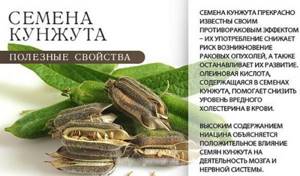
Sesame is the oldest oilseed crop, which was massively grown in the river valleys of the Middle East: the Tigris and Euphrates. It is an annual herbaceous plant that is cultivated for its grains.
Sesame halva can also be found under other equally popular names:
- tahini halva;
- sesame paste;
- tahini;
- tahini.
In the Middle East, sesame halva is called tahini due to the fact that in the Middle Ages sesame seeds were called “tahini”. Translated from Arabic, this word means “worms.” Since then, the name of this confectionery product has not changed and remains just as popular.
In Israel, Iran, Saudi Arabia, Jordan, and Syria, tahini halva is much more popular than sunflower halva.
Halva - benefits and harm
There was a time when scientists doubted the benefits of halva when they found active substances in the seeds. Alkaloids and natural antiseptics contained in the seed, at high concentrations, can have a negative effect on the human body. But the concentration of these substances in the seeds from which halva is made is insignificant. The human body easily copes with these substances.
By weight, about half of the seeds are fat—mostly unsaturated. An ounce has about 160 calories, 14 grams of fat, 5 grams of protein and 4 grams of fiber. Horseshoes resemble and, like okra, are technically fruits. When they are ripe, they split open at the slightest touch, releasing the seeds, hence one possible explanation for the expression "open sesame". Each container contains 50 to 100 or more seeds.
Harm of tahini halva
The seeds are usually scored and lightly roasted, which gives them a nutty flavor and a browner color. But you don't have to limit yourself to eating just the seeds, as they are used to make other delicious and nutritious foods. If you like sesame, you don't have to limit yourself to eating just the seeds, as they are used in other delicious and nutritious foods, including tahini and halva.
Contraindications and possible harm
As mentioned above, dessert should be consumed with great caution by people who are overweight or trying to lose weight.
The product should not be consumed by people with diabetes, as it contains a lot of sugar.
It should not be used by people with metabolic disorders, kidney, intestinal or stomach diseases.
This product should not be consumed by people who are allergic to its constituent components. It must be borne in mind that peanuts themselves are quite an allergenic product.
Sesame halva brings not only beneficial properties to the body, but also harmful ones. The high calorie content of oriental sweets and the risk of developing allergies when eating the dish causes a number of contraindications.
This is a rather difficult ingredient for the digestive system, so it is not recommended to eat it if you have certain diseases.
For constipation
In case of constipation, you can eat halva, but it is better to choose those varieties that contain sunflower. This dessert contains the maximum concentration of fiber, which will help cleanse the digestive organs.
When losing weight
In a small amount, halva will not harm your figure. Natural ingredients, on the contrary, will help replenish the lack of nutrients and minerals in an already depleted body. The high calorie content of dessert limits the consumption of the dish when losing weight.
For gastritis
The product is completely contraindicated for gastritis, along with pancreatitis and cholecystitis. Just one small piece can lead to a relapse or a new exacerbation. This is too heavy a dish for the body, especially during periods of gastrointestinal and liver diseases.
During lactation
During breastfeeding, women want to maintain lactation as long as possible. Halva will help prolong this period, increase milk volumes and increase its calorie content. Consumption will have a positive effect on the mother’s respiratory system, on the body’s metabolic processes associated with oxygen, and will also return the woman’s physical and emotional strength after a hard and stressful day. Tahini halva will help prevent cancer and improve vision.
It is better to introduce the product into the nursing menu from the second month of lactation. In this case, you need to monitor the baby’s reaction to the new ingredient. If the perception is positive, the portion of halva can be increased.
Halva with fructose
If you have diabetes, it is better to avoid halva, as it is a high-calorie dish containing fats and easily digestible carbohydrates, which negatively affect health. In this case, patients can try halva with fructose. This is a natural analogue of sugar, it is better absorbed and does not increase the blood glycemic index.
Sesame halva contains fast carbohydrates, which are unacceptable in the case of kidney stones, so this product is removed from the patient’s diet.
During pregnancy
During pregnancy, pregnant women are allowed to eat no more than 50 grams of tahini halva per day. It strengthens hair, bones and joints, cleanses blood vessels and normalizes the functioning of the heart muscle. Halva maintains hemoglobin levels and reduces the risk of anemia in both the woman and her child. Moreover, the serving size does not increase with the duration of pregnancy, rather the opposite.
Nursing mothers
The usefulness of halva for women while breastfeeding is obvious. But you need to introduce the product to the mother’s menu very carefully, observing the baby’s reaction. It is enough to eat a small portion of dessert to increase the fat content of mother's milk.
Oriental sweets with sesame help restore a woman’s body after childbirth, improve her mood and eliminate signs of postpartum depression. Due to its rich composition of nutrients, tahini halva is also beneficial for babies.
Sesame halva in its pure form should be introduced into a child’s diet no earlier than two years, and preferably from six to 10-20 grams per day. The consistency of the dish is not suitable for baby food, and the composition of the sweet dessert can cause tooth decay.
A child’s reaction to a new ingredient should be monitored at any age, regardless of whether he is an infant or an adult. In the absence of a negative reaction, you can gradually increase the serving size, bringing it to 30 grams. Children are not recommended to eat halva more than three times a week.
Composition and calorie content of sesame halva
If we consider the composition and beneficial properties of sesame halva, it is worth noting that the original delicacy cannot be compared with anything else. In addition to taste, the product is also rich in biochemical composition.
For every 100 g there are about 510 kcal. Such a rich energy composition was obtained thanks to:
- proteins – 13 g,
- fats - 30 g,
- carbohydrates – 51 g.
In addition to these elements, the finished product includes the following components, as a result of which the delicacy has the following beneficial properties:
- protein,
- magnesium,
- iron,
- calcium,
- sodium,
- phosphorus,
- zinc,
- potassium,
- copper,
- food acid.
Few sweets can boast such a set of elements. That is why it is not recommended to get carried away with halva, despite its beneficial properties, because it can cause significant harm to your health.
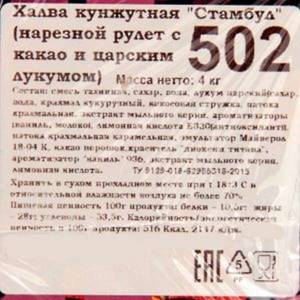
Composition and benefits
First of all, it is worth noting the calorie content of tahini halva - 500 kcal per 100 g of product. This is a lot for those people who eat the product in large portions and hope to lose weight. But this is normal for those who prefer to eat the product little by little to restore strength, improve mood, and saturate the body with useful substances.
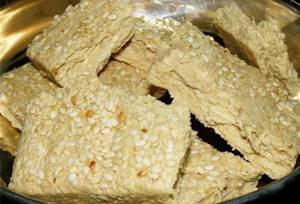
If tahini halva is consumed regularly, but in moderation, you can count on the following results:
- Help with pathologies of the cardiovascular system. Tahini paste contains a lot of fatty acids, which normalize lipid metabolism and prevent cholesterol from accumulating in blood vessels. The presence of potassium, calcium, sodium and magnesium in the composition allows you to maintain the functioning of the heart muscle at the desired level.
Tip: To assess the quality of tahini halva, just read its composition. A real oriental sweet is traditionally prepared from ground and peeled sesame seeds, molasses, honey or caramel syrup, and soap root. The last ingredient acts as a foaming agent, providing the product with a unique layered texture. In addition, the presence of poppy seeds, nuts, candied fruits and vanilla is allowed.
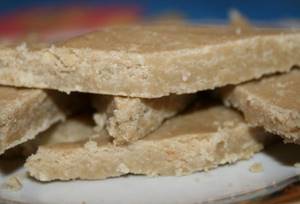
- The structure of bones and joints is maintained. If you eat 30 g of tahini halva every day, this will cover the body’s needs for a number of microelements necessary for these purposes by 20%. It is noteworthy that they are present in a set that ensures their most complete and rapid absorption. By including tahini halva in the diet of children, you can count on stable and consistent formation of cartilage, bones and teeth.
- Prevention and treatment of iron deficiency anemia. Although the product cannot boast of a variety of elements, iron is present in it in an impressive amount.
- There are not many vitamins in tahini halva, but even in small quantities, vitamins of groups B, A and E have a noticeable positive effect on the human body.
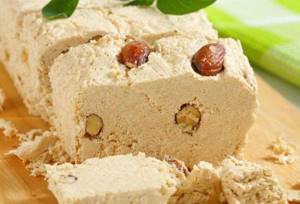
Tahini halva is much better than chocolate and other sweets in lifting your mood and fighting signs of depression. A small piece of oriental delicacy is enough to produce serotonin (the hormone of happiness) and increase the body’s energy reserves.
Recipe with coconut flakes
Of course, it’s much easier to go to the store and buy a ready-made dessert. However, we should not forget that the purchased product contains various preservatives, which not only increase the shelf life of the delicacy, but also negatively affect our health. Therefore, it is better to spend a little time and make sesame halwa yourself. Moreover, the technology for its preparation is so simple that even an inexperienced housewife can handle it without any problems. To make healthy homemade sesame halva, you should stock up on all the ingredients in advance. In this case you will need:
- Two hundred and fifty grams of butter.
- A teaspoon of vanilla.
- One hundred and fifty grams of sesame.
- A tablespoon of cocoa.
- One hundred grams of milk powder and powdered sugar.
A simple homemade recipe
Every housewife can prepare dessert at home using the following recipe.
You will need:
- Peanuts – 160 g;
- Flour – 0.3 tbsp. (≈ 40 g);
- Sunflower oil – 50 ml;
- Sugar – 0.3 tbsp. (≈ 70 g);
- Vanillin – 10 g;
- Water – 100 ml.
Step 1: Roast the peanuts, let them cool, and then peel them.
Step 2: Fry the flour in a dry frying pan until it becomes creamy.
Step 3: Grind the peanuts in a blender, then add flour and grind everything together.
Step 4: Add sugar, water and vanilla to the pan. Bring to a boil, then cook for 5 minutes, then add oil.
Step 5: Pour the resulting syrup into the mixture of flour and peanuts, mix. After that, put it in the mold and compact it. Let it harden and serve it on the table after half an hour.
Homemade sesame halva
It is not necessary to buy halva in a store or market; you can easily prepare the dish at home. The difference in taste will not be significant, but it will be prepared from high-quality products. For this you will need:
- Sesame seed – 200 g.
- Flour (whole grain wheat, sesame or nut) – 200 g.
- Sugar (for a healthier dish, it is better to take coconut or brown variety) – 130 g.
- Plant-based milk – 75 ml.
- Vegetable oil – 2 tbsp. l.
- Additives or spices as desired.
Sesame seeds are fried in a frying pan without oil for just 2 minutes. When a golden crust appears, they are sent to a blender and crushed until smooth. Do the same with flour - pour into a frying pan, lightly fry, add to the sesame mixture and beat again. Add vegetable oil to the blender bowl and mix the ingredients again.
In a separate container, mix milk with sugar and set to simmer. The mixture is brought to a boil, left for one minute, and while hot, poured into the sesame base and stirred. The mixture is placed on a baking sheet; the shape of the halva can be varied. Leave the dish to cool for half an hour, after which it is served.
The shelf life of purchased and home-cooked halva may differ. The labels most often indicate a period of up to 6 months. After opening the package, the product should be kept in the refrigerator.
On the shelves, halva is wrapped in foil. At home, it is better to transfer the aromatic dessert into a container with a tight-fitting lid. A dish prepared with your own hands can be placed in a glass container, closed with a lid and kept in the refrigerator for a short time.
There is no need to wrap the halva pieces in cling film. Due to interaction with air, the product loses some vitamins and beneficial microelements.
The chemical composition of a traditional dish from eastern countries and the halva sold in stores varies greatly. The energy value of dessert is on average 500 kcal per 100 g. High calorie content is influenced by:
- proteins – 13 g;
- fats – 30 g;
- carbohydrates – 51 g.
If the correct proportions are observed, tahini halva contains:
- protein;
- iron;
- food acid;
- magnesium;
- calcium;
- potassium;
- sodium;
- copper and other elements.
Chemical composition of tahini halva
| Calorie content | 509.6 kcal |
| Squirrels | 12.7 g |
| Fats | 29.9 g |
| Carbohydrates | 50.6 g |
| Alimentary fiber | 0 g |
| Water | 3.9 g |
| Ash | 2.9 g |
| Tocopherol (E) | 22 |
| Nicotinic acid (PP) | 6,4 |
| Thiamine (B1) | 0,8 |
| Riboflavin (B2) | 0,1 |
| Retinol (A) | 0,11 |
| Ascorbic acid (C) | 5 |
| Potassium (K) | 274 |
| Calcium (Ca) | 1400 |
| Magnesium (Mg) | 303 |
| Sodium (Na) | 41 |
| Phosphorus (P) | 402 |
| Iron (Fe) | 50,1 |
Is this oriental delicacy good for health or not?

The benefits of tahini halva, as well as the harm, lie in its rich biochemical composition. An invaluable storehouse of various vitamins and macroelements will provide the body with many benefits:
- Zinc is essential for the male body. It increases the reproduction of sperm and male sex hormones, regulates the normal activity of the prostate.
- Copper is necessary for the growth and maintenance of muscle tissue tone, normalization of blood circulation and oxygen transfer to organs.
- Vitamin A or retinoic acid improves the condition of the skin, nourishes and moisturizes it, and is also directly involved in maintaining vision, immune function and the production of growth hormone.
- Riboflavin (vitamin B2) strengthens nails, hair and generally helps maintain the immune system and its ability to resist colds.
- Potassium is essential for the heart and development of the human muscular skeleton. It helps maintain muscle tone and prevents the risk of stroke or other diseases of the cardiovascular system.
- Iron takes an active part in the processes of oxygen metabolism and the functioning of the body's respiratory system. It is believed that halva is the best and most delicious fighter against anemia.
To summarize, we can safely say that tahini halva heals the body, rejuvenates the skin, helps prevent the risk of heart disease, strengthens the musculoskeletal system and the respiratory system. In addition, thanks to the caramel nougat included in the delicacy, halva improves mood, helps the brain produce “happiness hormones” and generally has a beneficial effect on the human nervous system.
The energy value and all the beneficial properties of halva will be appreciated by pregnant women and nursing mothers, athletes, schoolchildren and people leading an active lifestyle. But we should not forget that sesame is classified as an allergenic seed and, if consumed excessively, can cause an unexpected reaction in the body. Therefore, eat sesame halwa in moderation.
Halva is a delicious oriental sweet. We are more accustomed to the delicacy made from sunflower seeds. But beans, various nuts or seeds can be processed into halva. In some countries, halva is a name for sweets made from wheat flour or semolina.
The ingredients are crushed and mixed to form a paste. In addition to traditional oilseed products, dried fruits, candied fruits, and raisins can be used in halva. The connecting link in the composition is a special edible foaming agent. It is mixed with caramel mass, which allows you to get the fibrous structure of halva.
Tahini (sesame seed) halva is a traditional delicacy in the Middle East. It is also loved by residents of the Balkans and Mediterranean.
Everyone knows that sweets in large quantities affect our figure and the condition of tooth enamel. But how can you resist temptation, because it’s so delicious?! Let's first figure out what the benefits and harms of tahini halva can be.
Benefits of peanut halva for the body
Due to its beneficial properties, even medical professionals recommend consuming peanut halva.
If we consider the beneficial health properties, it is worth noting:
- beneficial effect on the skin, prevents premature aging;
- It is worth noting the special benefits of peanut halva for women planning pregnancy. Due to its beneficial properties and the content of a large amount of folic acid, the product can have a positive effect on the health of the mother and fetus;
- for the male body, peanut product is useful because it improves well-being and increases potency, but we must not forget about the possible harm; you need to consult a specialist in advance;
- the beneficial properties of the product help protect the body from harmful microbes;
- has a rejuvenating effect;
- helps normalize blood pressure;
- takes part in metabolism;
- since peanut halva contains a lot of iron and vitamins, this can significantly improve brain activity;
- prevents the appearance of cancer cells.
In the process of preparing the product, oil obtained from ground nuts is used. It is used in folk medicine to prevent the appearance of malignant tumors.
Attention! Nutritionists are of the opinion that peanut halva brings both benefits and harm to the body, so the daily intake should be up to 15 g of the product, which will not harm the figure.
Calorie content of the product
Halva is very high in calories. 100 g of product contains 516 kcal, so you need to be careful when consuming this delicacy, especially for overweight people. If you overuse sweets, the kilograms will grow by leaps and bounds.
Note. By eating 100 g of the product, you can get a third of your daily energy needs.
The high calorie content of halva is based on a fairly high content of fats and carbohydrates.
The BJU ratio is as follows:
- proteins – 12.7 g;
- fats – 29.9 g;
- carbohydrates – 50.6 g.
Calorie content of tahini halva
Tahini halva is a high-calorie product:
- 100 g contain more than 500 calories;
- 2 kilograms can satisfy the energy needs of an adult man engaged in heavy physical labor;
- High caloric content provides ~50% carbohydrate content.
If you decide to start losing weight, sweets in the near future are strictly contraindicated. This includes halva, despite its excellent taste, it can “settle on the sides” and even one slice will negate the results of an entire workout.
Fast carbohydrates can be useful immediately after a workout if your goal is to gain muscle mass. At first, after starting to go to the gym, the athlete begins to lose weight, and thanks to easily digestible carbohydrates immediately after training, this process can be slightly slowed down and results can be achieved faster.
Harm of halva
After studying the beneficial properties of halva, it is difficult to imagine that it can cause harm to the body. But its use in large quantities or low quality can negatively affect his condition.
In order to enjoy delicious halva without harming the body, it is recommended to eat a piece of no more than 30 grams per day. This is a filling product and is quite high in calories. The calorie content of sunflower halva is more than 500 Kcal per 100 grams of product. Uncontrolled use of it can result in the appearance of:
- Caries;
- Diabetes mellitus;
- Obesity;
- Diathesis;
- Digestive problems;
- Allergic reaction.
Low-quality, stale halva is also harmful to the body. A delicacy made from sunflower seeds that was stored incorrectly or whose expiration date has expired can easily lead to poisoning. It can be provoked by cadmium accumulated in the seeds.
And in order to eliminate possible harm, you should take the choice of halva responsibly, as well as its storage, which we will talk about next. But before that, I suggest watching a video about how tasty and healthy oriental sweets are produced, and what harm its poor quality can cause.
It is quite possible to prevent harm from eating sweets made from seeds or nuts. To do this, you need to know not only how much of it you can eat daily, but also who should stop eating it altogether.
Halva is contraindicated for:
- Diabetes mellitus;
- Obesity;
- Allergies to products containing oil;
- Pancreatitis.
Halva for pancreatitis, cholecystitis, gastritis
Is it possible to eat halva if you have pancreatitis, gastritis or cholecystitis? With such problems, halva is prohibited. It's all about its composition, which is too heavy for an organism whose work has already been disrupted. A small piece of this delicacy can cause a relapse and a serious exacerbation of the disease.

DIET AFTER GALL BLADDER REMOVAL How to live a full life without a gallbladder Find out more...
How to prepare the product yourself
Tahini halva is a fairly simple dish to prepare, but it has many positive health properties.
Required Ingredients
To make this sweet, you need two glasses of sesame seeds (500 grams), half a glass of coconut flakes, three tablespoons of raisins (for sweetness), and dates (about 12 pieces). You can add a vanilla pod.
It is worth mentioning separately what halva does not go with. If you eat halva along with chocolate, meat, milk or cheese, get ready to feel all the “delights” of an upset digestive system. For this reason, you should not buy chocolate halva.
Step by step process
The first step is to prepare the products for use
To do this, it is important to thoroughly grind the sesame seeds using a coffee grinder or any other available device, peel and pit the dates, and rinse the raisins with cold running water.
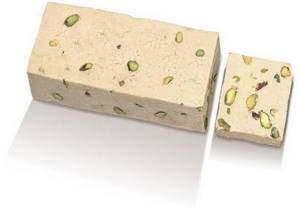
- After these procedures, the dates need to be mashed until a homogeneous thick mass is formed. It's worth noting that you can also use honey instead of dates.
- Coconut flakes, dates and raisins (whole) are added to the sesame mass, everything is thoroughly kneaded by hand.
- Next, you need to prepare a form for hardening the halva (preferably a food-grade plastic container in which to place the bag). The prepared mass is laid out in a container, and compacted (pressed) by hand to more securely hold the ingredients together.
- The workpiece is placed in the refrigerator for cooling.
- After this, carefully remove the prepared dessert from the mold and enjoy the delicious, satisfying and healthy tahini halva.
How to choose the right halva
Before purchasing halva in a store, you should carefully check whether the integrity of the packaging has been damaged. A product that is not hermetically packaged loses a lot in quality because oxygen accelerates the oxidation process of fats, causing them to go rancid.
A high-quality product does not have any stains on the surface, including oil stains. There should be no foreign inclusions inside or on the break in the form of husks or caramel veins. When cutting a product with a knife, it should not crumble, and wrinkled edges are the first sign that the manufacturer has introduced cheap substitutes into the recipe. Only sesame halva has a bitter taste, while sunflower halva has a fibrous-layered structure.
Harm of sesame halva and contraindications
For every 100 g there are about 510 kcal. Such a rich energy composition was obtained thanks to:
- proteins – 13 g;
- fats - 30 g;
- carbohydrates – 51 g.
In addition to these elements, the finished product includes the following components, as a result of which the delicacy has the following beneficial properties:
- protein;
- magnesium;
- iron;
- calcium;
- sodium;
- phosphorus;
- zinc;
- potassium;
- copper;
- food acid.
https://www.youtube.com/watch?v=Q2S9tb5G2Zk
Few sweets can boast such a set of elements. That is why it is not recommended to get carried away with halva, despite its beneficial properties, because it can cause significant harm to your health.
- due to the large amount of fatty acids, lipid metabolism improves, which prevents the accumulation of cholesterol;
- if you eat up to 20 g of product daily, the body will be completely saturated with the micro- and macroelements necessary for normal functioning;
- prevents iron deficiency in the body;
- Vitamins of groups A, B and E have a beneficial effect on the functioning of the body.
Tahini sweetness can replace chocolate and lift your mood and relieve depression.
- nuts;
- sesame;
- sunflower seeds.
On the one hand, the product can cause a strong allergic reaction, and on the other hand, due to its properties, it can be very useful for the body
Since sesame delicacy is a rather complex product that can cause disturbances in the digestive system not only in adults, but also in children, it must be consumed with extreme caution
- You need to take 2 tbsp. sesame seeds and flour, 200 g sugar, 100 ml milk, 6 tbsp. l. vegetable oil and vanilla sugar (small amount).
- In a hot frying pan without adding vegetable oil, fry sesame seeds until golden brown. If necessary, you can buy roasted sesame seeds, but the price will be much higher.
- The roasted seeds are placed in a blender.
- Start frying the flour.
- Granulated sugar is added to the milk and the syrup is boiled.
- Sesame is ground to an oily mass, then mixed with flour, butter and syrup.
- After this, you need to knead the mass, make it homogeneous, give it any shape and let it cool at room temperature.
As a flavor enhancer, you can add coconut, chopped nuts, poppy seeds, and cocoa.
- Most often, an allergic reaction is observed to sesame and soap root, so before starting to use the product, you should consult a specialist, as there is a high probability of harm to health;
- tahini products can cause diathesis in children due to the high sugar content;
- Sesame halva is high in calories, due to its high content of fats and carbohydrates;
- Abuse of products can cause increased metabolism.
- since halva does not tolerate sunlight, the packaging must be sealed and made of foil;
- if oil discharge is visible on the surface of the product, this indicates that the production technology has been violated;
- when cutting, the shape is maintained, no crumbling is observed;
- complete absence of hard caramel veins. If they are present, then the technology is broken;
- the cut is smooth.
If you choose a product carefully, you can purchase really high-quality and healthy sesame halva, which will not harm the body if you eat it wisely.
Sesame halva is sold in vacuum packages made of foil. Tightly closing containers are ideal for further storage. Many housewives cut halva into small pieces, put it in a glass jar, tightly close the lid and store it in the refrigerator.
Before purchasing halva in a store, you should carefully check whether the integrity of the packaging has been damaged. A product that is not hermetically packaged loses a lot in quality because oxygen accelerates the oxidation process of fats, causing them to go rancid.
A high-quality product does not have any stains on the surface, including oil stains. There should be no foreign inclusions inside or on the break in the form of husks or caramel veins. When cutting a product with a knife, it should not crumble, and wrinkled edges are the first sign that the manufacturer has introduced cheap substitutes into the recipe. Only sesame halva has a bitter taste, while sunflower halva has a fibrous-layered structure.
How much does 1 kg cost in Russian stores?
Halva is a common product that can be bought in stores and supermarkets in the Russian Federation. The confectionery product is sold by weight and packaged.
| Name of halva variety | Price, rub/kg |
| Peanut | 306,00 |
| Sunflower | 160,00 |
| Tahini-peanut | 325,00 |
| Sunflower with poppy seeds | 235,00 |
In the summer of 2012, residents of Ingushetia set a new record, which was included in the Book of Records of the Russian Federation. They produced the largest block of halva, weighing 4 tons and more than 100 meters long. More than 20 thousand people were treated to dessert.
Making halva
Let's figure out what halva is made from? It all starts with seeds. They are usually dried with hot air. According to the old recipe, the seeds, peeled from the hull, must be fried, and exclusively on a cast-iron Dutch oven. Only then will the seeds have a golden crust and a unique smell. It is important to constantly stir the seeds; if they burn, the halva will taste bitter. During frying, almost all the moisture from sunflower seeds evaporates. But the amount of healthy oils does not decrease. In order for the grains to grind well, the amount of moisture in them should be no more than 2%. Each seed is half oil. Kandalatchi sends the roasted seeds into an extractor, which thoroughly grinds the kernels, turning them into a protein mass. An oily paste made from crushed seeds is called halvin. This is the basis of an old recipe. The paste is ground several times until it becomes liquid, like condensed milk. Then, following the old recipe, the craftsmen add a little vanilla. Next, prepare the caramel. First, syrup is made from water, sugar and molasses. The finished sugar syrup should be thick and viscous. To turn the sweet mass into caramel, a decoction of soap root is added to it. The roots of this Mediterranean plant contain substances called saponins, which, when shaken, form a thick white foam. To prepare halva, the soapwort decoction is mixed with sugar syrup and shaken into a stable foam. The result is snow-white caramel. Then the magic begins. Caramel is combined with halvin. Both ingredients being mixed are very liquid. How does the dessert become hard and crumbly? This is where the magic lies. The future halva is kneaded with oars, as was done in the East many centuries ago. The trick is to gently pull out the caramel strands while kneading. One thread can stretch up to 10 meters. Only with such thorough kneading will the halva turn out airy and fibrous. If a mixer were to mix the mass, it would break the fragile caramel threads, making the dessert crumbly like sand. That is, if you use mechanisms when making halva, you will never get a real, proper delicacy. After kneading, the halva is completely ready. Now it can be packed into boxes. Chocolate halva is also kneaded by hand. It is important not to overdo it here, otherwise the sweetness will turn out not airy, but hard.
Where did halva come to us from?
Since ancient times, the Eastern world has been famous for its rich culture and scientific achievements:
- Arabic numerals, which the whole world uses today;
- Chess from India, one of the most popular games in history;
- Artillery, whose homeland is the Arab world;
- Islam and Buddhism are world religions;
- Lots of delicious delicacies.
And if some discoveries influenced the world and really changed it, then the same halva simply delighted those with a sweet tooth.
One of its varieties was tahini halva:
- Appeared in Iran, two and a half thousand years ago;
- It began to spread throughout the territory of the former Union from Odessa;
- Did not gain widespread popularity among the people;
- You can easily find it in a themed store.
The delicacy is high in calories, but tasty and healthy for the body. If you don't lean too hard and don't try to develop diabetes. Everything should be in moderation, even good things.
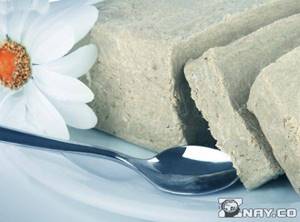
In this video, culinary specialist Alina Maksimova will show you how to make tahini (sesame) halva yourself:
Who is this dessert contraindicated for?
Like any other product, sesame halva, the benefits of which have long been known throughout the world, can cause harm to the human body. It is advisable to exclude it from the diet of those who have been diagnosed with increased blood clotting.
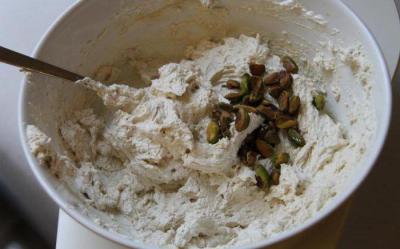
Also, this delicacy is not recommended for children under three years of age. This is due to the fact that it contains a high concentration of fat, the breakdown of which the child’s body cannot cope with. In addition, sesame halva should not appear in the diet of people suffering from individual intolerance to one or more components used for its preparation.
Benefits and features of tahini-peanut halva
Like any other product, tahini-peanut halva can bring both benefits and harm to human health. If you follow the general recommendations for consuming tahini halva, then it can have only a positive effect on the body and not cause harm:
- thanks to the presence of potassium, stroke can be prevented;
- helps improve fat metabolism;
- helps maintain bones and joints in good condition;
- if you consume the product regularly in acceptable quantities, you can improve the exchange of oxygen in the body;
- lifts the mood;
- has a rejuvenating effect;
- improves the general condition of nails and hair;
- moisturizes the skin;
- strengthens the immune system.
Undoubtedly, thanks to its beneficial properties, the product can bring significant benefits to a person, but one should never forget about the harm, possible consequences and personal intolerance of some of the components that make up halva.
Question answer
Is it possible to eat halva if you have type 2 diabetes? Recipes for several types of halva have been developed for diabetics, and all of them are made using sweeteners. A regular product sold in a store is prohibited for use by persons suffering from diabetes, regardless of its type.
Is it possible to eat halva with pancreatitis? If the disease is in the acute stage, then this product is completely excluded from the diet. In the chronic form and in remission, the daily dose of oriental sweets should not exceed 20 g.
Is sunflower halva good for weight loss? A complete refusal of sweets provokes eating and nervous breakdowns. When losing weight, it is better to eat halva prepared independently, consisting of honey, fructose, sunflower seeds and flax. Daily dose – maximum 30 g.
Delicacy from the Middle East
What is known about tahini halva:
- Known for more than two thousand years;
- It was first prepared in the territory of modern Iran;
- It is high in calories and dangerous for diabetics;
- Contains many vitamins and mineral elements;
- Made from ground sesame seeds and molasses;
- Began to spread throughout the CIS from Odessa;
- It never gained the popularity it deserved.
If adults can still somehow limit themselves in sweets, then for children forcing themselves to put the delicacy aside is an unrealistic task. You should not completely exclude halva from your child’s diet if he does not have diabetes; it is better to simply control and dose its consumption. Not forgetting that allergies to sesame are not uncommon, especially in childhood.
The next oriental sweet that tried to conquer our region was tahini halva, from which this product is made, it is often indicated even on the price tags - ground sesame as a protein base and molasses for taste.
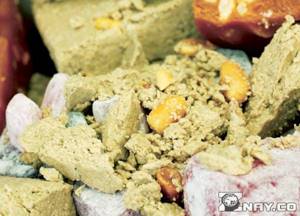
What is tahini halva made from?
The recipe for making tahini delicacy is known only to specialists involved in the production of oriental sweets, and it is kept secret. It is for this reason that the taste of the finished product and its beneficial properties vary depending on the country.
For example, some specialists mix all the necessary ingredients by hand and do not recognize any other method. It is believed that this is the only way that oriental sesame sweets acquire airiness and unique taste.
The main ingredients are:
- sesame protein mass;
- honey;
- granulated sugar;
- syrup;
- foaming agent
It would seem that preparing it yourself is not so difficult, you just need to mix all the ingredients and put the mass under a press for a while, but it’s not so simple. Mixing all the ingredients is an art, in the process of which it is customary to adhere to secret technologies.
